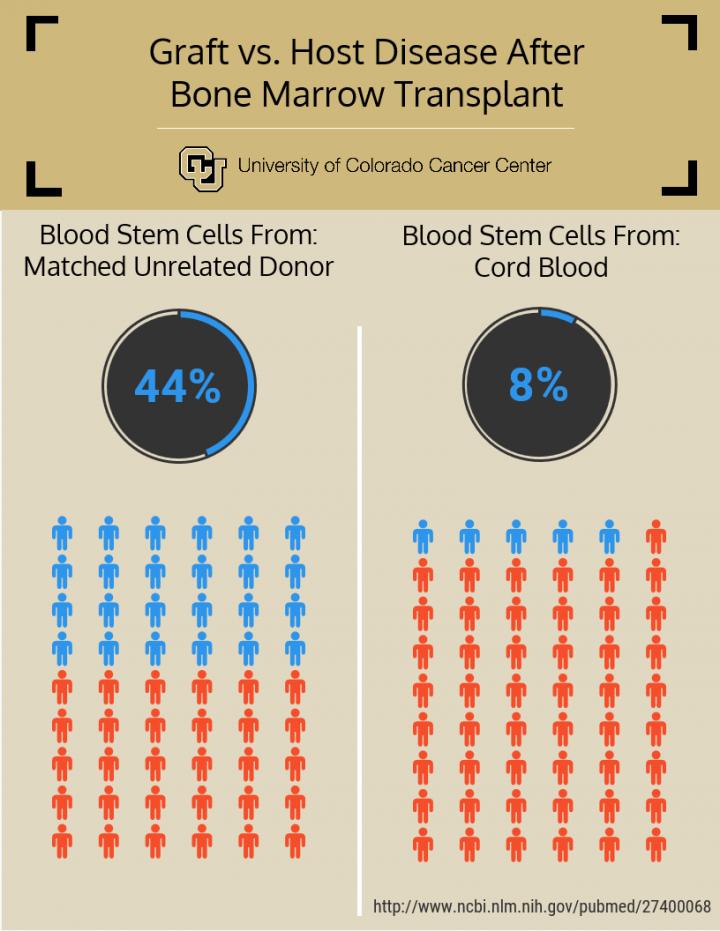Cord blood outperforms matched, unrelated donor in bone marrow transplant

University of Colorado Cancer Center study shows reduced chronic graft-versus-host disease with cord blood, compared with blood from unrelated matched donor, three years after bone marrow transplant. Credit: University of Colorado Cancer Center
“When you do an allogeneic transplant – when someone else is the donor – the new blood system has the potential to attack the patient. This is graft-versus-host disease, which can be debilitating and even fatal. Our results show that, long term, receiving a cord blood transplant is less likely than receiving a transplant from an unrelated, matched donor to result in graft-versus-host disease,” says Jonathan Gutman, MD, investigator at the CU Cancer Center and Clinical Director of Allogeneic Stem Cell Transplantation at University of Colorado Hospital.
A common treatment for blood cancers is to erase a patient's leukemic blood system and then regrow a new blood system using donor blood stem cells.
There are four possible sources of donor cells: a matched, related donor (commonly a close family member), a matched, unrelated donor (from a database of 25 million people who have agreed to donate), umbilical cord blood (from a bank of stored samples), and haploidentical transplant (a promising technique requiring only a half match with a related donor).
The closer the match between donor cells and a patient's blood system, the less chance the new blood system will attack the patient's tissues, i.e. the less chance of graft-versus-host disease.
A matched, related donor is the accepted first choice. Genetics dictate that siblings have a 25 percent chance of matching. Those without a matched, related donor have 70 percent chance for Caucasians or only 10 percent chance for other or mixed ethnicities of finding a matched, unrelated donor in databases of people who have agreed to give if needed. Cord blood is immature and thus does not need to be as closely matched to be acceptable as a donor source. (Haploidenical transplant is beyond the scope of this article.)
“Historically, doctors have reserved cord blood for patients without a match,” Gutman says.
However, this flow of preference is increasingly questioned as data including the current study demonstrate that cord blood may be equal to or better than transplant from a matched, unrelated donor.
“A lot of centers reserved cord blood transplants for their worst cases, and so it got an early reputation for being less successful. It also costs a bit more – it takes cord blood cells a little longer to get going and so patients need to be supported a little longer. However, when you look past the first 100 days – a point at which many centers stop collecting data – there is clear evidence that cord blood outperforms cells from matched, unrelated donors,” Gutman says.
Gutman also points out that bone marrow transplants require art as well as science. Centers like University of Colorado Hospital that are especially experienced with cord blood transplant have evolved systems to best support patients and optimize all transplant related issues, potentially leading to better outcomes than less experienced centers using similar treatment.
The current study, specifically, compared 51 consecutive patients receiving CBT with 57 consecutive patients receiving MUD. At 3 years post transplant, in addition to he above difference in severe chronic graft-versus-host disease (cGVHD), overall rates of cGVHD were 68 percent following MUD and 32 percent following CBT. Again at 3 years, patients receiving CBT had been off immunosuppression since a median 268 days from transplant; patients receiving MUD had not ceased immunosuppression to a degree that allowed researchers to determine the median.
“As a result, we have chosen to use cord blood as our first choice in cases where a matched, related donor is unavailable,” Gutman says.
Media Contact
All latest news from the category: Health and Medicine
This subject area encompasses research and studies in the field of human medicine.
Among the wide-ranging list of topics covered here are anesthesiology, anatomy, surgery, human genetics, hygiene and environmental medicine, internal medicine, neurology, pharmacology, physiology, urology and dental medicine.
Newest articles

Sea slugs inspire highly stretchable biomedical sensor
USC Viterbi School of Engineering researcher Hangbo Zhao presents findings on highly stretchable and customizable microneedles for application in fields including neuroscience, tissue engineering, and wearable bioelectronics. The revolution in…

Twisting and binding matter waves with photons in a cavity
Precisely measuring the energy states of individual atoms has been a historical challenge for physicists due to atomic recoil. When an atom interacts with a photon, the atom “recoils” in…

Nanotubes, nanoparticles, and antibodies detect tiny amounts of fentanyl
New sensor is six orders of magnitude more sensitive than the next best thing. A research team at Pitt led by Alexander Star, a chemistry professor in the Kenneth P. Dietrich…





















